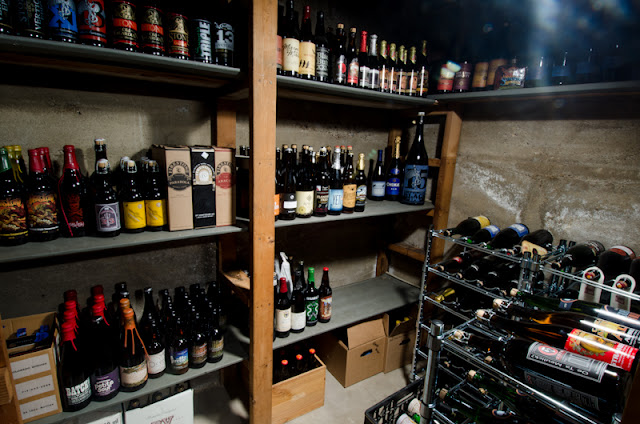Cellarmanship: An Introduction to the Joys of Cellaring Beer
The mainstream tells you beer needs to be consumed as fresh as possible. Hops degrade leading to astringency and lackluster aromas. Oxygen has more of a chance to attack a beer, providing cardboard-like off flavors. UV harms the beer by reducing good hop bitterness and creating similar compounds found in a skunk’s aroma. Temperature fluctuations can cause chemicals to accelerate at different rates leading to all sorts of off-flavors including vinegar, butter, and bandaids. It could be infected making it undrinkable in short time. So it would seem that time is against you and your beer.
All the things listed above make it seem like storing beer for an extended amount of time would always be bad. So why are certain aged beers sought after, collected, and held in such high regard? Why are there verticals, why are there best AFTER dates, and why are there nerds stocking up on beer like it will help them survive the zombie apocalypse?
Time and proper storage can smooth bitterness and develop certain flavors like currants, caramel, leather, and toffee along with many others. Now I understand that this may seem contradictive to the first paragraph in this article, but it just depends. I will still stand by the notion that all beer should be tried as fresh as possible, but how do you choose what to buy two of in order to have one later?
We will break this informative series on cellaring beer down into three segments: Why Cellar, How to Cellar, and What to Cellar. We will also be including interviews with brewers and other beer professionals for their take on Cellermanship.
Why cellar? If there are all these beer predators out there trying to lure your beer into a van full of candy and off-flavors why take the risk? Is it worth it? What happens if you stash this bottle away, let it collect dust, post pictures of it on instagram, name it, and stare at it for years and then it turns out to be crap? Well simply put... that sucks. Our series will hopefully help you avoid that. What if the beer turns out amazing? What if those boozy young flavors meld together into leathery sweetness, burnt toffee whiskey goodness that makes your tongue orgasm?
Do breweries cellar? To an extent they all do. The term cellar in a brewery can vary from where the serving tanks are stored, a warehouse that houses barrels, to a cold storage room that stores beer before it’s distributed and everything in between. The common meaning refers to storage in a controlled environment until the beer's final goal. Belgians have been cellaring beers for a long time. Gueuzes and Lambics progress. The funkiness of the beer changes; the flavors meld; and they often describe an old unblended lambic as a champagne after time. Gueuzes in fact take some cellaring time to properly carbonate as the young sugars are consumed leading to an effervescent carbonation. Lagers used to be cellared in hillsides to keep them cool while they ferment and clarify. More breweries are creating Reserve Societies, leading them to cellar beer for later parties, events, or special releases. Whatever the end purpose is, there is a universal recognition that beer needs to be taken care of before it’s released to the public, whenever that may be.
Craft liquor stores and beer bars commonly cellar beer too. Their reasons vary as well. Certain places will sell older bottles around events, do tastings of verticals, or gather enough bottles for a sour, imperial, barrel-aged type of tasting event. Beer bars will hold onto beers and release them on a bottle list years later, often charging 2-5 times the original cost. Different beers are held onto for their rarity, hype, or style so that they can be enjoyed later.
My personal reason for aging beer has morphed into educating myself, experimenting, and sharing. Not to hide the truth, it began like an episode of Hoarders. Give me all the beer and give it to me now. That definitely gave me a great head start but led to some quick lessons about what is and isn’t age-able. I really enjoy tasting how a beer ages and morphs sometimes into something completely new. I would attribute most of this educating interest to homebrewing and using store bought beer to educate myself on how my beers might age.
I also like opening beers with friends. I like it when they get excited about what we are opening. I like tasting what high alcohol content, brettanomyces, lactobacillus, other wild or funky yeast strains do to a beer over time. It’s rewarding to have a special beer for a special occasion as well. There are plenty of reasons to cellar beer, but it takes patience. It’s hard to buy a delicious bottle of beer and then hide it away. That’s another reason to buy two. It does no good to see how a beer develops if you don’t know how it started.
So why should you get interested in cellaring? The wine industry and consumers have been cellaring so that tannins and acidity could meld with sugars and fruit flavors. They understand that wine peaks, and there comes a place where these flavors combine to be at their best. Maybe that beer you bought isn’t at its peak right off the shelf. I have had beer that was better after ten years than its current newer version tasted. Being able to provide an amazing “vintage” beer for a special occasion or gathering can be satisfying. Maybe it’s a limited release so you buy a few to make sure you get them and space out drinking them but want to store them properly. Or maybe you’re geeky for craft beer too and just want to learn more about it.
I understand it’s not for everyone, but it adds a whole new layer to beer drinking. More and more breweries are supporting aging their beer. Next time you buy a beer from The Bruery, Deschutes beer, or any other bomber or 750mL take a look at the label and you might be surprised.
Stay tuned for interviews with New Belgium’s Eric Salazar and Lauren Salazar as well as the how-to of cellaring.
-Written by Scott Simmons
- - -
Stay up to date with Focus on the Beer. You can receive email updates and join us on our Facebook page.





